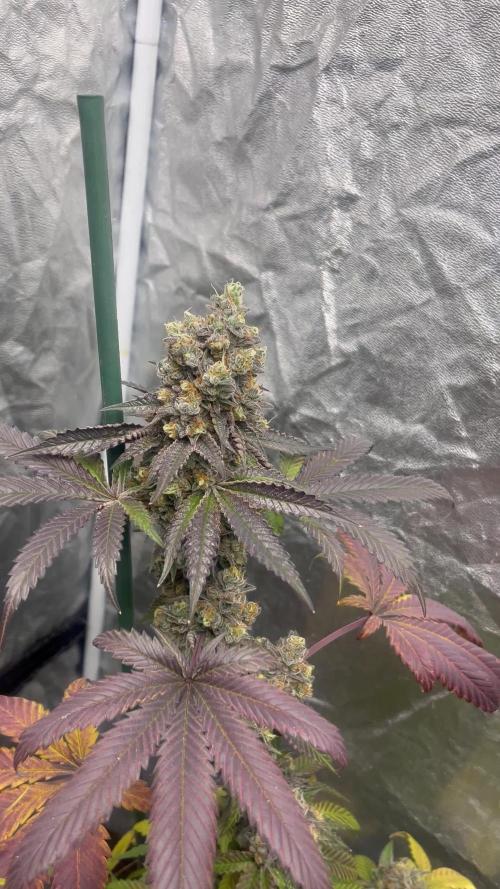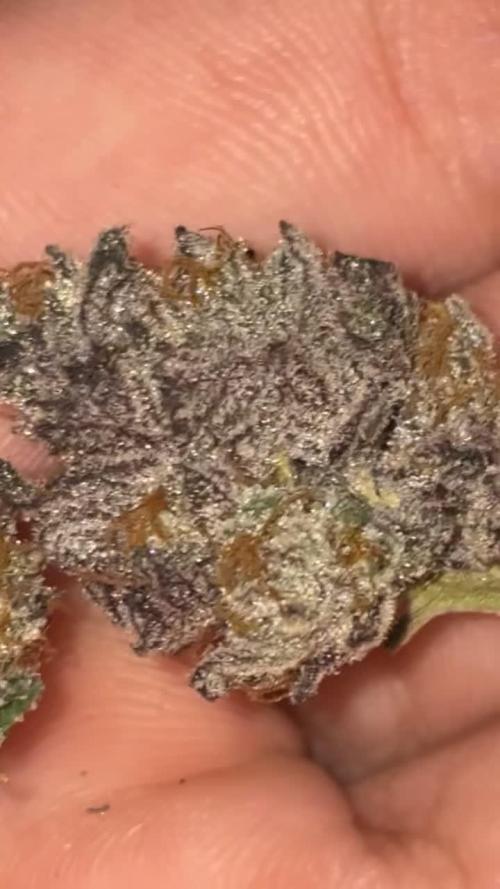The Grow Awards 2026 🏆 







































Likes
Comments
Share


@TheGreenLeopard
Follow
Gréât week. Thai choc looks unreal. Pineapple Express is a funky little bonsai .. all ripener now for the upcoming week. Thai chocolate needs a bit more flower time than her piers so I can enjoy the show a little longer. Her color has really come through. Video summary of all strains included. Thanks for coming
Likes
23
Share


@Ieiogrow94
Follow
Eccoci qui!!
Siamo alla fine genetica bellissima odore e resina ci sono vediamo alla fine che ci viene fuori!
Grazie a tutti per il supporto!
❤️🔥🌲
Likes
109
Share


@OrganicNature420
Follow
Day 80
Looks better than last week. Fed her more to get her going again. Lovely citrus smell coming from her pistols. She's going to go on alot longer than the others so need to think of a game plan. Hoping loft will be cool enough for cure otherwise this will have to go outside or in the house as I need the air con for the other girls. They have priority %100 🌱💚
Decided to lower temps on advice so will see how it goes
Happy growing gang 👍🏻
Likes
5
Share


@Sativa763
Follow
Day 49 after switch.
very nice i would say :)
everything is getting bigger and frosty.
no complains so far.
last week watering with PK 5-8, then just water until she´s finished.
Likes
12
Share


@eldruida_lamota
Follow
Vamos familia, actualizamos la novena semana de floración de estas Gelato 44 de RoyalQueenSeeds.
La temperatura que estuvo entre los 24-26 grados y humedad dentro de los rangos correctos.
En cuanto a las plantas las veo verde sano, estiraron bien y ensancharon bastante también.
Quitamos los nutrientes y les dimos solo agua esta semana.
Hay que reivindicar que en este armario no tengo trips ni plagas.
Las flores están madurando bien, por el momento todo correcto, os dejé también alguna novedad y un cambio en la sala, agradecer al equipo de Mars hydro por el nuevo TSW2000. (los últimos 5 años cultive solo con los leds de esta marca) los cuales probé, TS600, TS1000, TS3000, TSL2000.
- os dejo por aquí un CÓDIGO: Eldruida
Descuento para la tienda de MARS HYDRO.
https://www.mars-hydro.com
Hasta aquí todo, Buenos humos 💨💨💨
Likes
7
Share


@Mokorelsare1
Follow
Day 43: stretch phase is over, she grew fast in last week from 28 cm to 45 cm in just a 7 days. Now she's focused on fattening up her buds!
I decided to feed her every other watering instead of every watering, but Cal-mag is must for every waterings!
HST - Supercroping at day 47: these nodes went too high, so i did the thing! Please don't repeat this at home xD
Day 48 plant seems okay, 2 of supercroped nodes are coming back! 3rd will be back soon as well! This plant can take any stress!
This is the last day of the week, next few weeks we will see some flower bulking action😁
Likes
3
Share


@Earthsower
Follow
The double kush cake has gone through stress with a little bit of bleached leaves and red veins heat spots on the leaves all due to heat stress which has caused her to stunt So I have relocated her to her original spot as it is cooler. She is still growing under the light distance of 60cm. The double kush cake is receiving 100ml of fluids every three days she stands approximately 52cm from the soil.
Likes
32
Share


@Platinouuu
Follow
Un poco de entrenamiento para llevarlas en su propio rumbo sin stress adicional futuro. Solo seran algunas guianzas de ramaa. Gracias a todos por sus buenas vibras y ayudas! Buenos humos
Likes
10
Share


@Geili_Seili_fireinfireout
Follow
Seit anfang woche 4 in blüte is sie nur mehr am explodieren.
I love this cut🔥
Die besten umd vitalsten stecklinge (weil im labor getestet) findet ihr wie immer bei ROOTS-FARMS österreich. The best in austria maybe europe
Likes
7
Share


@iLoveGoodWeed
Follow
She has stretch very nicely and at the end of week I can see that she will start flowering next week .
Likes
26
Share


@Ukfarmer420
Follow
I have loved this grow and for my 1st scog run I have learnt alot to imply to my next run!, so keep an eye out for my next organic scrog, using marshydro equipment and zamnesia seeds 😀 thanks for all your support and likes and I look forward to giving you another diary soon 💚👌👊 happy growing.
I am looking for a organic nutrient range for my next run if you can help me, give me a shout💪💚
Likes
4
Share


@Huckleberry39
Follow
She is starting to come together finally. Ive never seen a plant like this one. But, I love an underdog. She is getting some nice trichome production already, which is always good. Taking a full dose of nutes and loving it. So far so good. I am loving 420 Fast buds!!!
Likes
4
Share


@TTerpz
Follow
Harvest day! Whole plant gets chopped and hung
First day of of dry 10/2/25
Day 4 of dry 10/6/25 buds are drying up not much chlorophyll smell left except for on the bigger fan leaves that I kept on the plant buds are giving off a nice pungent smell
Likes
Comments
Share


@GM_Gardening
Follow
Till now, everything is working well.
Sometimes I even get 32 degrees.
No Problems at all
Likes
4
Share


@Brentb2607
Follow
10 days of darkness during the flush begins. Had great results with Wanda and her genetics. Blessed for a first grow. Cut Wanda down at the end of the week. She’s now drying. I will be giving a thorough review for my harvest diary. Excited to share what I’ve experienced and learned from this grow.
Processing
Likes
27
Share


@Silverback_Guerilla
Follow
3/16:
Rain let up for half the day, but more tonight...damnit...
They are due for a watering tomorrow, but with the high RH, maybe not...
3/17:
They weren't ready for water yet, so I slept for a few bonus hours! (rare)
Both of these plants continue to pack on the pistils with no signs of slowing down...I thought surely the shortie would be ready to flush this week, but she's not even close to ready yet.😕 It rained for most for the day....again...
3/18:
I watered them with about 1/2 gallon each including terpinator, signal, sweet & sticky, cal-mag, armor si, endoboost, humic acid, and a little cha ching. It rained all night again..and most of the day today. I took some photos with the qb's turned off and a 135w 5500k CFL on..
3/19:
It rained all night and several times again today...ffs....I've started building an Ark in my free time 😁
3/20:
Rained again on and off today..RH still too high...
3/21:
I took the shortie out of the closet today to inspect her trichomes. I took about 2-dozen close-ups and zoomed in really close on my PC and couldn't find a single amber anywhere...and prolly only about 30% cloudy at this point..
I went ahead and took some cuttings from her while I had her out. Hopefully I can get at least one to survive and grow outdoors this season. I also took some cuttings from the FFT#6 (the other shortie), and I started a couple of other FFT's (5 & 7) which I'll train out as horizontally as possible to match the shortie's heights.
3/22:
Rained again last night several times...and again today for a couple hours...ridiculous. Woke up with RH at 65%!!!
Been chatting with other FFT growers and they all seem to be losing a lot of produce to botrytis...I'm starting to freak out..😳
Processing
Likes
20
Share


@Divs_darkroom
Follow
I turned off one of the mars panels. My garden isn't big enough to need that much light. So I just have the hlg65 and 1 mars panel going. This girl drinks like crazy. And she is quick to droop her leaves to tell you she's thirsty. Grow a lot in the past week. This will be the biggest autoflower I have grown so far.
Likes
27
Share


@DeepRootsGrowTrees
Follow
Gelato-K By Kannabia Seeds
Week #19 March 15th-22nd
Week #8 of Flower
About 4 weeks left. She continues to stack and swell her buds are cover in trichomes.
Likes
40
Share


@Ganjagrandaddy
Follow
Day 47 ( 10 in flowering): Happy days here in the Farm. These ladies have been stacking up their bud sites ready for the big build it seems. Limbs are nice and chunky to support the upcoming baseball bats , and their general health and colour is looking good. I have the rh at 70% and will lower that soon to encourage some oil. The Los girl is flying with very little input needed. She will get a top dress of charge, life cycle and watered in with biosys tea on her next feed. The Coco Mc girls are vibrant and a beautiful green colour so should be powerhouses for the bud stacking. I do want to defoliate a bit but will wait a little longer while they still sort their stretching out. All the budsites are able to get light so their bushiness isnt an issue yet.!
.I think they will go to another 5 weeks before harvest though which gives them ample time to pack in those buds.
Until next week , peace and love gd fam
Processing
Likes
4
Share


@TegridyCal
Follow
She has been the queen of the family since the first week, she stood out above all for speed, reaction to toppings and beauty. Truly a super strain for Zamnesia has managed very well every time we have raised it even in difficult conditions. It has a heavenly smell, one of the strongest ganje like smell, very sweet, caramel that very much reflects the original essence of one of the most classic strains found in California.


















